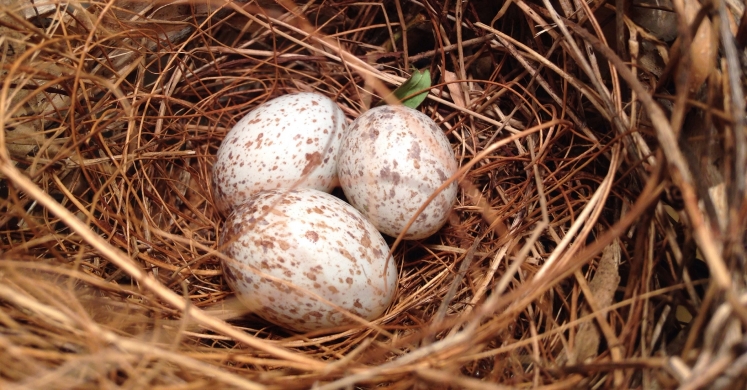Blog

#bioPGH Blog: All the Colors in the Nest - The Story of Eggshell Coloration
 A resource of Biophilia: Pittsburgh, #bioPGH is a weekly blog and social media series that aims to encourage both children and adults to reconnect with nature and enjoy what each of our distinctive seasons has to offer.
A resource of Biophilia: Pittsburgh, #bioPGH is a weekly blog and social media series that aims to encourage both children and adults to reconnect with nature and enjoy what each of our distinctive seasons has to offer.
Robin’s egg blue is a distinctive color, guiding many a spring fashion palette, yet that brilliant blue is only one example of the wide variety of bird egg colorations in the wild. What purpose does the color of an eggshell serve? There are plenty of hypotheses out there to help answer this, so let’s explore some, shall we?
Before we dig too far into the “why,” let’s take a look at the “what”: how diverse are the colors and patterns of eggs? Many of our local feathered neighbors—such as cardinals, mockingbirds, chickadees, house finches, house sparrows—have pale beige to white eggs with speckles of browns, grays, greens, or blues. The cedar waxwing and blue jay have very pale green, gray, or blue eggs, similarly speckled with browns, grays, and other earth tones. Woodpeckers like the hairy, downy, red-headed and pileated, all lay plain white eggs. Our famous robins lay their beautiful blue eggs, as do eastern bluebirds. Any of these egg colors will vary, however, depending on a number of factors including geography and the mother’s diet or overall health. For example, some eastern bluebird eggs are pure white, most are a pale blue, and some are a slightly darker blue. Variation abounds in nature, yet all of this variety comes primarily from just two different pigments, biliverdin (green-blue) and protoporphyrin IX (red-brown).
Now, then…why the colors? What could be useful about a colorful egg and what do the different colors do? Well, the short answer is that there is no short answer. Numerous studies have looked at the life histories of birds in comparison to their egg shell coloration, and sometimes there is a clear reason why a species’ eggs would need to be a particular color, but sometimes there is not. Some species of birds have different behavioral traits, but their eggs are similar because the species are related. On the other hand, some species of birds are only barely related, but their eggs are nearly identical. In a wild twist called “brood parasitism,” some eggs are made to mimic the size and color of a different species, and the mother will lay her “mimic” eggs in another bird’s nest to be raised by parents of a completely different species! Other brood parasites, though, will have eggs that look completely different from the eggs in the invaded nest, yet the invader chick is still raised by an unwitting host mother. Thus, we can see there is still quite a bit of mystery behind egg colors, but we do have some insights.
At the most basic level, a tan egg with brown speckles is a well-camouflaged egg. Depending on the nest location, camouflage could reduce egg predation, and the prevalence of patterned egg shells is positively correlated with ground nesting species. This makes sense since there would be a higher risk of predation on the ground. However, this doesn’t tell the entire story; cavity-nesters also often have speckled or otherwise patterned eggs. It would be assumed that camouflage wouldn’t be as high a priority for these birds since egg colors are costly and the need for the colors would be low for them.
Another possible explanation for egg color is the trade-off between protecting the embryo from damaging UV rays that could penetrate the shell while still keeping the embryo cool. A darker egg provides more protection from ultraviolet radiation, but could also absorb too much sunlight raising the temperature into an unsafe range for the developing embryo. Thus, for many eggs, the color of the shell seems to be striking a balance between UV light protection and heat protection.
So in the end, there is still quite a bit we don’t know about why eggs are different colors—but that is part of why nature is exciting! There is still so much that we don’t know, so much to learn, and so much to understand. Whether it’s a mystery about why bird eggs are a certain color or how whales can hold their breath for so long or how flowers know when to bloom, never stop exploring!
Connecting to the Outdoors Tip: While eggs may be amazing to see, remember that mama bird still needs privacy to feel safe. If you spy a nest, appreciate it from a distance. Many folks wonder this time of year what to do if they spy a recent nestling (just hatched from those colorful eggs!) on the ground. If you do, the Animal Rescue League has helpful information about what to do.
Continue the Conversation: Share your nature discoveries with our community by posting to Twitter and Instagram with hashtag #bioPGH, and R.S.V.P. to attend our next Biophilia: Pittsburgh meeting.
Resources
Audubon Society: Cracking the Code on Eggshell Coloration
Lahti and Ardi 2016—Shedding Light on Bird Egg Color: Pigment as Parasol and the Dark Car Effect
Soler et al. 2003.-- Evolution of host egg mimicry in a brood parasite, the great spotted cuckoo
Image Credits: Wikimedia user Captain-tucker CC-BY-SA-4.0 and Steven Depolo CC-BY-2.0

